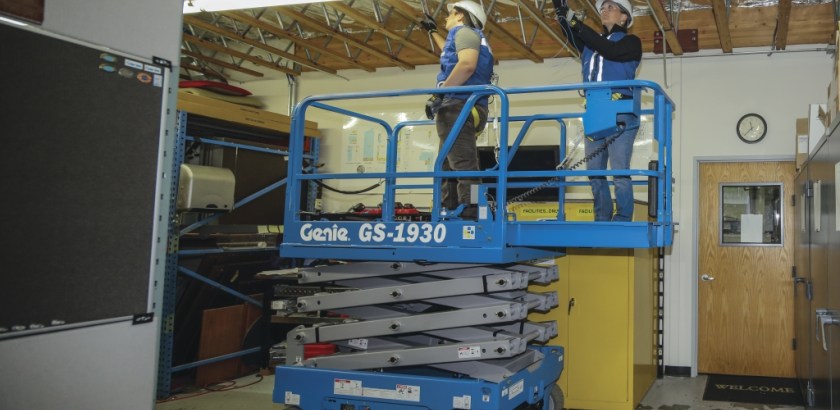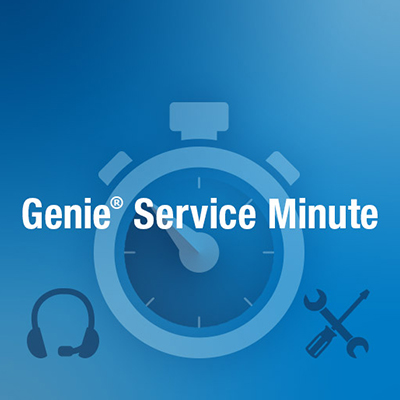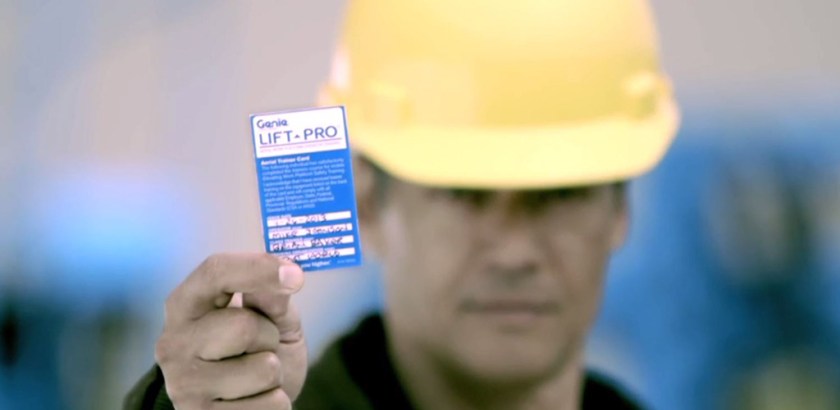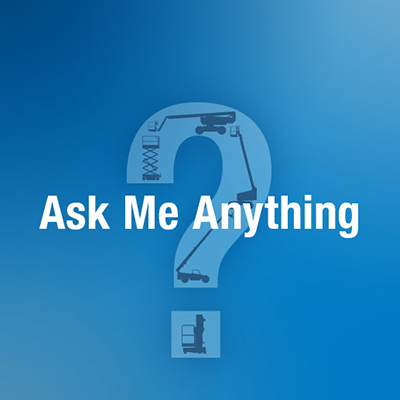Aerial Operator Training | Ask Me Anything December 4th - 8th
by Genie On Dec 4, 2017, 03:00 AM
Subscribe To Aerial Pros
Filter by tags
A huge thank you to everyone that participated in this Genie Aerial Operator Training | Ask Me Anything event! Stay tuned to Genie Aerial Pros and our social media channels for the next Ask Me Anything Session.
--------------------------------------------------------------------------------------
Welcome to Ask Me Anything with the Genie Team on Aerial Operator Training. Watch the brief introduction below for this event:
Additional articles on Aerial Operator Training can be found here on Aerial Pros:
- What You Need to Know about Aerial Work Platform Training
- Evolution of Aerial Safety and Training Programs
- What is the Difference Between “Familiarization” and “General Training?”
You can view the Q & A below from this event:
Q: Does everyone have to be retrained to the new standards
A: Hi Richard, Yes, once the standards are finalized and published, all operators will have to be trained up to the new standards. Genie will offer a new Online and Classroom-based MEWP Operator Training course as soon as the standards change.
Q: Will there be new training materials and if so when will they be available
A: Hi Richard. Genie will launch a new MEWP Operator Training Program, both Online and Classroom-based, as soon as the standards are finalized and published.
Q: Is there a new training video, literature, and quizzes available? How do we acquire them?
A: Hi Kip. Genie will launch an entirely new MEWP Operator Training and Train the Trainer course with updated content as soon as the standards are finalized and published.
Q: We just established a Company-wide aerial and TH training program using the Genie online programs and by the end of next week will have about 35 people trained as “trainers” or “qualified persons” to do the final stage of the training – The hands-on.
How do we best go about centralizing the enrollment of customers or employees who need the training? We would like to assign a single person or office to that task but need to be able to clearly explain the enrollment process so we can devise the billing and implementation process.
A: Hi Ben. You may have noticed that the Genie Lift Pro site has been down since the 28th and will be back up and running tomorrow. We have upgraded to a new LMS and replaced the original courses that were written in Flash with new courses that are written in HTML5. The big change that pertains to your question is that we are going away from the tradition registration system and moving to scratch cards only. This will dramatically simplify the registration process. You will be receiving information via email this week that will explain the changes and the new process. If you have any questions, please email me at AWP.Training@terex.com.
Q: How can we get a updated training for trainer ? Trainer to train operators in our teritory.
A: if you are already a trainer you can buy the materials from your local Genie Dealer. You may want to consider waiting until after the new ANSI updates are published to do so, which should be after the first of the year.
Q: In the weatherproof storage compartment/box on lifts, what documents are required to be in there? (i.e. manual of responsibilities, ANSI standard, owners manual?)
A: In the weatherproof storage compartment you need to have the operators manual for the specific machine and the ANSI manual of responsibility. the Aem safety manual is not required to be on the machine.although Genie supplies the AEM safety manuals with all units.
Q: “In the weatherproof storage compartment you need to have the Operators Manual for the specific machine and the ANSI Manual of Responsibilities. The AEM Safety Manual is not required to be on the machine, although Genie still supplies the AEM Safety Manual with all units.”
Is this “ANSI manual of responsibility” the same as the Manual of Responsibilities published by the SAIA found athttps://shop.saiaonline.org/shopdisplayproducts.asp?id=12&cat=MANUALS-not the actual ANSI standard?
A: Hi Craig. The ANSI Manual of Responsibilities for each model is taken directly from the ANSI Standards. It is a very small part of the standards that pertains directly to the responsibilities of manufacturers, dealers, owners, users and operators.
Q: As the aerial lift safety instructor for Alexander Equipment in Bourbonnais, IL I am concerned with getting updated training material from Genie as soon as it becomes available. When do you expect the new rules to be published and when do you expect to have the new training package ready for distribution? Thanks, Tim Boshaw
A: Hi Tim. Genie will launch an entirely new MEWP Operator Training Program as soon as the ANSI A92 standards are finalized and published. All of our training kits will be switched over at that time.
Q: Part of our safety requirements is requesting Product Dealer concurrence that the GTH 1544 lifting eye at the end of the boom is rated for the machine design lift capacity. Please acknowledge this is correct.
A: Yes the lifting eye at the end of the boom is rated for the machine design. Just make sure you are using the correct load chart for the machine you are using.
Q: how do the changes to ANSI A92 and CSA B354, impact operator training for MEWPs (perhaps the top 3 impacts / changes)
A: Hi Robert. There are many changes that will impact operator training and it’s difficult to identify the top three. For example, in the U.S.A., operators only require retraining if their employer deems it to be necessary. In Canada, operators must be retrained every five years. Operators will have to be trained on how to properly select the correct MEWP for the application, as well as the need for a Safe Use Plan and a Rescue Plan. Operators will also have to perform Occupant Training for any other individuals in the platform before they can take them up. To see a detailed narrated presentation on all of the upcoming changes, please click Upcoming Changes to the ANSI A92 and CSA B354 Standards
Q: Fall protection in vertical lifts, any changes?
A: Hi Robert. ANSI and OSHA have not made any changes to PFPE requirements on scissor lifts. No fall protection is required on scissor lifts or manually-propelled and self-propelled vertical lifts. The guardrails provide fall protection on those machines. However, please note that many employers and job sites, as well as some provinces in Canada, do require personal fall protection equipment on these machines as an internal policy.
Q: what about instructors for operator training; who is deemed competent, are the “proof of training” requirements for operators and the course/s structure addressed in any changes?
Is “familiarisation” defined and differentiated compared to “training”?
A: Hi Robert. ANSI and OSHA define a qualified person as “…one who, by possession of a recognized degree, certificate, or professional standing, or by extensive knowledge, training, and experience, has successfully demonstrated his/her ability to solve or resolve problems related to the subject matter, the work, or the project.” Obviously, a person cannot be a trainer for aerial work platforms unless they are also a properly trained and qualified operator (which is why we always qualify individuals as operators at the start of our Train the Trainer courses). Operators must be able to show proof of training upon request. That must include their name, the date of training, the name of the person providing the training, the training organization and the equipment classifications or models covered in the training. The confusion surrounding the difference between “Familiarization” compared to “Training” is a huge problem in our industry. Far too many “instructors” will provide simple familiarization and the operator considers themselves to be training, which is not the case. “Training” involves a qualified trainer providing General Training as outlined by ANSI in their ANSI Manual of Responsibilities, typically in a classroom or online, that covers a range of machines and is general in nature (covers most makes and models of aerials). It also includes a detailed hands-on practical component that includes a workplace inspection, pre-operation inspection, function tests and actual operation of the machine to demonstrate proficiency in the actual operation of the machine. This will typically take 3-6 hours depending upon size of class and number of equipment classifications to be covered. “Familiarization” is machine-specific and is usually performed by a qualified person prior to using the machine. It can take 15-60 minutes or more depending upon the machine model. A great way to see this outlined is to take an ANSI Manual of Responsibilities out of the manual storage compartment on any aerial platform and read it. Please make sure to replace the manual when you are done. If you need any additional information on the subject please email me at AWP.Training@terex.com.
Q: Hey guys, “horizontal” force on the platform ratings are clearly marked but not so easily explained…50-150 pounds (per square foot?)(per square inch?). Is there an easy way to explain this to operators and occupants based on their body weight and the force of “leaning” on a rail, etc…?
A: Hi Rob, the manual force requirements are specified by the standard to help account for the possibility of forces outside of the platform applying to the MEWP, such as an occupant reaching outside the machine and pulling on the work area. The load is a force (lbs), not a pressure (lbs/in^sq) and is applied at a single point, it is assumed to act in the worst possible position and direction. To think about this simply, it would be similar to attaching a rope to the point on a MEWP that would be worst case for the machines stability and pulling with a load of 50lbs.
Q: Will you have a conversion kit for old units?
A: Hi Lewis. That depends upon what type of conversion you are referring to. We do have conversion kits for our Lift Guard Contact Alarm secondary guarding feature if that is what you are referring to. If you are referring to converting an existing aerial work platform to meet the new ANSI Standards (load sense, terrain sensing, etc.) the answer is no. The cost to convert an existing machine would be prohibitively expensive. All existing machines will be grandfathered in after the standards do change and will not be required to have the new design features.
Q: What type and length lanyards does genie recommend to be used on boom lifts? I have heard self retracting lanyards are preferred and that OSHA has cited for using 6 ft. lanyards.
A: Hi Michael. OSHA requires that the operator must ensure that they cannot free fall more than six feet and they cannot strike the surface over which they are operating (ground or structure that they may be rotated over). Each operator must determine their own minimum fall distance calculation that takes into effect their height, length of lanyard being used, length of shock absorb expansion, boom deflection and ground obstacles. In my videos I have been wearing both a fall restraint lanyard (for working anywhere from the ground up to approximately 18.5 feet) and a six-foot shock-absorbing lanyard for work above 18.5 feet so I can move about the platform. Wearing a six-foot shock-absorbing lanyard below that height would be a violation of the OSHA regulation. Genie also approves the use of a six-foot self-retracting lanyard that has been approved for such use by the Fall Protection Equipment manufacturer. If you would like additional information on this topic please email me at AWP.Training@terex.com.
Q: Is the new information incorporated into the training on lift Pro?
A: Hi Mitch. Once the standards have been finalized and published, we will switch over to the new Online Classroom-based MEWP Operator Training Program that will reflect all of the new information and requirements.
Q: Why are companies similar to Genie not discussing the changing ANSI / CSA changes affecting aerials training?
A: Hi Stan. That’s a great question! Genie has been heavily communicating the pending changes to the ANSI A92 and CSA B354 Standards since spring of this year (please see Changes to the ANSI and CSA Standards You Need to Know About). We know that this information is critical for our customers to know and understand and our goal has been to educate the industry and help our customers prepare for the changes so they are ready when they come. Not only have we been posting many articles in our Aerial Pros section of our website and in several industry publications, we have been presenting the information at important industry events such as the ConExpo Educational Series, AEM Product Safety Conference and the 17th Annual Upper Peninsula Safety Conference. We have performed three webinars on the topic and we have an online narrated presentation on the topic that we make freely available to anyone who requests it. I can’t comment on why some of the other manufacturers have remained relatively silent on the topic but I will say that I believe that the more entities out there talking about these changes, the better off our customers will be and that is absolutely the most important issue to us.
Q: How will the new ANSI standards be WRITTEN to demonstrate to a current LiftPro trained MEWP operator that they will need to be re-trained to the new standards given that both the old and new standards do not stipulate an expiration period on general training? (U.S. Market) Thanks.
A: Hi Akio! The new ANSI A92 standards contain the following verbiage: Under “Definitions”: Retraining: Required instruction based on the user’s observations or evaluations to maintain a previously trained person’s status as a qualified operator. Under “Requirements for training, familiarization and authorizing operators”: This training shall be provided to MEWP operators and their supervisors and include the inspection, maintenance, use, application, and operation of MEWPs. Supervisors of MEWP operators shall also complete training as specified in this Standard. Only personnel properly trained in compliance with this Standard and who have received unit-specific familiarization shall operate a MEWP. The user shall determine if personnel are qualified to operate the MEWP prior to authorization. Training shall be required for each of the classifications of MEWP defined in this Standard. Manufacturers, dealers, owners, users, operators, and brokers shall comply with their responsibility to support training requirements defined in this Standard. All users of MEWPs shall either train and familiarize or ensure that personnel whom they authorize as operators, supervisors and occupants have been trained and familiarized in accordance with this standard. Users shall retain records of training in accordance with this Standard.
Q: Where can we see or obtain a copy of the draft version of the new ANSI standards?
A: Hi Andrew. Unfortunately, draft copies of the new ANSI Standards are only currently available to those who sit on the ANSI committee and will not be made available to the public until they have been finalized and published.
Q: For currently trained operators, will the re-training consist of just the new theoretical, classroom portion or will it also need to include the hands-on? If it doesn’t need to include the hands-on, then should we describe it as “retraining” or “training up” given the importance of the hands-on requirement in the ANSI definition of the word “training” and the confusion that often occurs with that word. Thanks!
A: Hi Akio! I prefer the term “training up” but it will be up to each employer to make the determination of how they want to handle that requirement. The hands-on practical component will not change so that won’t be affected. All operators will have to be trained up to the new standards whether by completing an update course (Genie is planning on developing a course to assist current trainers with attaining the knowledge to meet the requirement) or by complete re-training.
Q: I am interested in finding out if you offer repair training on your larger booms at your Redmond location, if you do could you please email me info. on dates ect. we have some z80 lifts I would like to get a couple of my mechanics trained on some diagnosing tips and using the lap top. Thanks for your time and I hope to hear back from you.
sincerely, Brad Demchuck (service manager)
A: Hi Brad. Genie offers technical service training for Genie Dealers at our Oklahoma City location only at this time. Information and training schedule can be found at https://www.genielift.com/en/support/training.
Q: Why are the standards changing?
A: Hi John. ANSI and CSA have had their own standards in the United States and Canada respectively for the past 15 years or so. Bringing the ANSI A92 and CSA B354 standards more closely in line with the rest of world will create greater opportunities for the manufacturers, owners and users of aerial equipment worldwide. The new standards will be based on current ISO standards, although there will be some slight differences.The change will allow North American aerial equipment manufacturers to be in closer alignment with global markets like Europe, Australia and China. The benefit to our customers is that it will enable them to more easily trade new and used equipment in many countries without worrying about country-specific configurations. And finally, in my opinion, the changes will dramatically improve operator and job site safety.
Related Posts

OSHA National Safety Stand-Down 2018: What is the difference between “familiarization” and “general training?”
One of the most frequently asked questions we get in the training department at Genie is “what is the different between ‘familiarization’ and ‘general training’ for aerial work platforms?”
Continue Reading

Service Minute: The Importance of Technician Training Programs
Training in the aerial industry is very important — a life is at stake each and every time someone gets into a piece of aerial equipment.
Continue Reading

Case Study: Electrical Training Alliance Partners with Genie to Offer Aerial Operators’ Training for the New Generation of Apprentices and Journeymen
Safety is always job one on every work site.
Continue Reading


